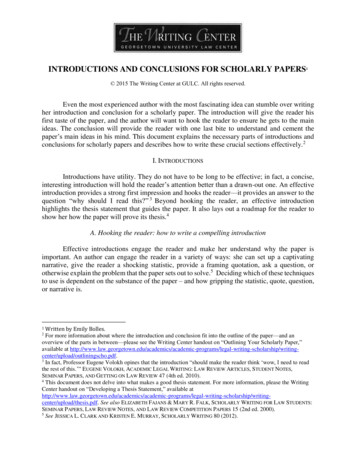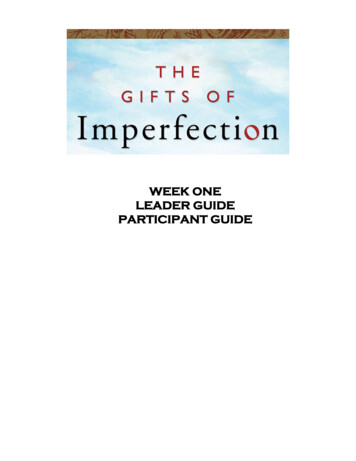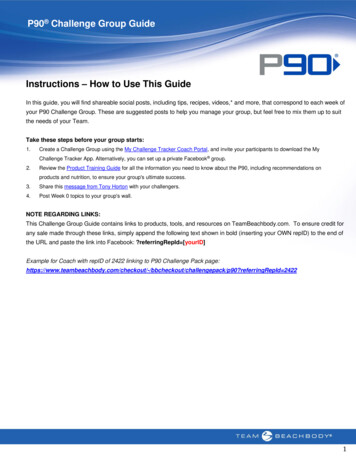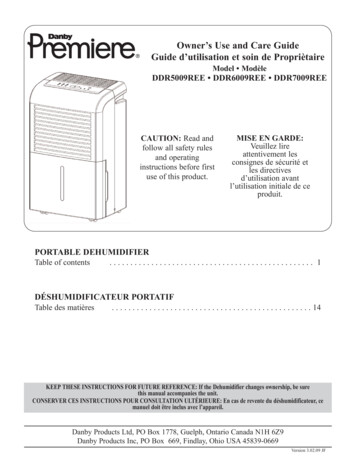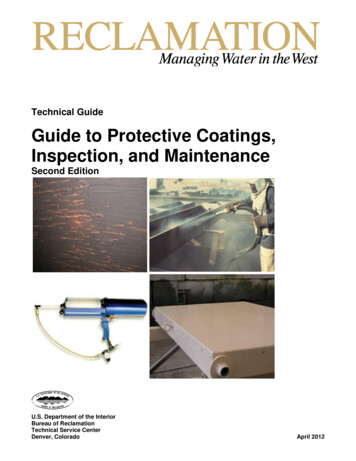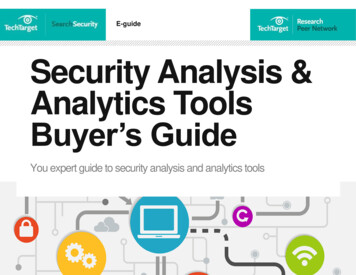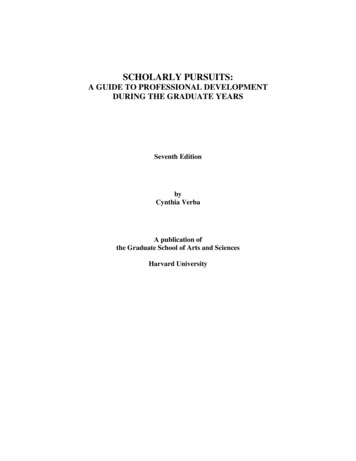
Transcription
SCHOLARLY PURSUITS:A GUIDE TO PROFESSIONAL DEVELOPMENTDURING THE GRADUATE YEARSSeventh EditionbyCynthia VerbaA publication ofthe Graduate School of Arts and SciencesHarvard University
SCHOLARLY PURSUITS: A GUIDE TO PROFESSIONAL DEVELOPMENT DURING THEGRADUATE YEARSSEVENTH EDITIONWITH SAMPLE APPLICATION ESSAYS, FELLOWSHIP PROPOSALS,CURRICULUM VITAE AND COVER LETTERSFROM CANDIDATES IN THEGRADUATE SCHOOL OF ARTS AND SCIENCESOFHARVARD UNIVERSITYbyCynthia VerbaA Publicationof theGraduate School of Arts and Sciences
Very special gratitude goes toall the graduate students and PhD’swho shared so generouslyabout their experiences in academe,without whom this booklet could not have been written.Copyright 2005by the President & Fellows of Harvard University
ABOUT THE AUTHORCynthia Verba has been serving as Director of Fellowships in the Graduate School of Arts and Sciencessince 1986. Prior to that, she was Associate Director at Harvard’s Office of Career Services, withresponsibility for overseeing academic and nonacademic career services for graduate students and PhDs.Her work at Harvard in the area of professional development for PhDs began in 1978. She holds a PhD inmusicology from the University of Chicago, and continues to be active as a publishing scholar andteacher. She was a fellow at the Bunting Institute of Radcliffe College in 1987, and received a fellowshipfrom the National Endowment of the Humanities in 1983 to further her research in musicology. She hasalso served as Chair of the Committee on Academic and Nonacademic Employment of the AmericanMusicological Society from 1979-1985. She has been teaching courses in music history at the HarvardUniversity Extension School since 1977.Her publications in the area of grantsmanship and professional development include the following workswhich have been published by the Graduate School of Arts and Sciences: Minorities in Academe: TheConcept of Becoming a Scholar (revised version, 1996), the annual fellowship guides, The GraduateGuide to Grants, The Harvard Guide to Postdoctoral Fellowships, and Fellowships for Harvard GSASStudents. She has also written Careers for Musicologists, published by the American MusicologicalSociety in 1986, and was a contributor to Teaching and Beyond: Nonacademic Career Programs forPhDs (published by the Regents of the University of the State of New York in 1984). In the field ofmusicology she has published Music and the French Enlightenment: Reconstruction of a Dialogue,1750-1765 (Oxford: Clarendon Press, 1993), and more recently, a chapter, “Music and theEnlightenment” in The Enlightenment World (London and NY: Routledge, 2004), and a forthcomingchapter, “Between Reason and Feeling: Gender in the Tragédies Lyriques of Jean-Philippe Rameau” (tobe published by Yale University Press), as well as numerous articles and reviews.i
TABLE OF CONTENTSI. SCHOLARS AT WORK: AN OVERVIEW OF THE ACADEMIC PROFESSION . 1Scholarly Beginnings: The Decision-Making Process to Become a Scholar in a GivenField . 1What Do Scholars Do, And Where Do They Do It? . 1What Are Some of the Steps on an Academic Ladder? . 2What Are Some Distinctive Features of Life in Academe? . 3What Are Some Things You Should Know About the Academic Job Market? . 4Faculty Salaries . 5Minorities . 5Women . 6Citizenship. 7II. VIEWS FROM MINORITIES IN ACADEME . 8Report on a Panel Discussion: “Building for the Future, Dealing with the Present” . 8III. THE DOCTORAL PROGRAM AND PROFESSIONAL DEVELOPMENT:PLANNING AND SETTING PRIORITIES. 11The Nature of the Graduate Program, Its Principal Stages. 11Roadmap to the Academic Advising Process in Graduate School: The Formal andInformal Routes to Helpful Advising . 13After the General Examinations: Refining or Choosing a Dissertation Topic in the Humanities andSocial Sciences, Maintaining Momentum .15Practical Tips on the Mentoring Process Across All Fields, From a Recent PanelDiscussion . 15Special Issues for Women: Access to Mentoring and Other Channels for ProfessionalDevelopment . 17The Harvard Task Force on Women in Science and Engineering: RecommendationsConcerning Equal Professional Development Opportunities for All Students . 18Acquiring Teaching Experience and Improving Teaching Skills. 18Engaging in Professional Activities: Attending Conferences, Delivering Papers. 19Acquiring Language Skills in Relation to Research. 20Participating in Departmental Activities . 20Seeking a Position as House Tutor, Freshman Proctor, or GSAS Resident Advisor . 21Broadening Career Options . 21Sample Application Letter for a House Residential Tutor Position . 22Acquiring Letters of Recommendation and Setting up a Dossier . 23Combining Personal Life with Professional Life in Academe . 23Four Tips for Graduate Students from the Incoming Dean of GSAS:Orientation, 2005 . 24IV. FINISHING THE DOCTORAL DEGREE IN A TIMELY FASHION:THE DISSERTATION AS A KEY FACTOR . 26Stages of the Dissertation Process in the Humanities and Social Sciences . 26The Dissertation from the Student Perspective: Choosing a topic, choosing advisors, surviving theresearch and writing stage, getting a life 28The Dissertation from the Faculty Perspective . 31ii
V. GRANTSMANSHIP IN SUPPORT OF STUDY OR RESEARCH: WRITINGA FELLOWSHIP PROPOSAL OR STATEMENT OF PURPOSE . 34Making Use of the Fellowship Services of GSAS . 34Applying for Fellowships in the Early Stages of Graduate Study: The PredissertationProposal . 35Writing the Dissertation Proposal in the Humanities and Social Sciences, SpecialConsiderations for Research Abroad . 36Project Review for Research on Human Subjects . 44Some Basics on Taxes and Fellowships . 44Samples of Winning Fellowship Proposals: Predissertation Fellowship Proposals . 46Samples of Winning Fellowship Proposals: Dissertation Fellowship Proposals . 58Sample Biographical Essays for Fellowship Applications. 87Sample Curriculum Vitae for Fellowship Applications . 90VI. PUBLISHING SCHOLARLY WORKS . 92Publishing Journal Articles or Book Reviews . 92Publishing Books . 95VII. BEYOND THE DOCTORAL PROGRAM: APPLYING FOR TEACHINGPOSITIONS. 100Entering the Academic Job Market: The Dissertation as a Key Factor in the Decision. 100Steps to Take Once You Decide to Enter the Job Market; Treating These Steps as anInvestment. 100Perfecting Your Curriculum Vitae . 101The Dissertation Abstract: Discussing the Dissertation’s Contribution to the Field. 104Writing the Cover Letter, Enclosing Supplementary Material. 105Keeping Informed of Vacancies and Choosing Where to Apply . 107Acquiring Letters of Recommendation for the Job Hunt . 108Having Letters Sent: Dossier Service and/or Individual Letters 108Keeping a Record of Your Applications . 109Follow-Up . 109The Interview . .109Short Interviews At Professional Meetings . 110On Campus Visits and the Job Talk . 113Negotiating a Contract . 115The Two-Career Family: The Job Search for Two Academic Jobs . 116Special Considerations for Foreign Students. 117On Not Giving Up . 117Sample Curriculum Vitae and Cover Letters for Academic Employment . 118VIII. BEYOND THE GRADUATE PROGRAM: APPLYING FOR POSTDOCTORALFELLOWSHIPS AND OTHER RESEARCH POSITIONS IN THE FIELD OFTHE PhD. 149Applying for a Postdoctoral Position in the Sciences: .150Panel Discussion: Landing Your First Postdoc in the Sciences 150Applying for Postdoctoral Positions in the Humanities and Social Sciences:iii
Writing a Formal Proposal for a Regular Posted Position . 152Other Types of Research Positions in the Field of the PhD . 154Choice of Resume Format . 154Research and Related Positions—Nonacademic Resumes and Cover Letters . 156APPENDIX A: GUIDE FOR TEACHING FELLOWS ON WRITING LETTERS OFRECCOMENDATIONS . 168Writing Letters of Recommendation and Its Relationship to Teaching . 168The Contents of a Letter of Recommendation. 168How to Acquire Sufficient Information to Write an Effective Letter . 169Further Refinements: Handling the Easiest Case, the In-Between Case,and the Most Difficult Case . 170Questions of Format and Style, Co-Signed Letters . 171Sample Letters. 172APPENDIX B: TWO ESSAYS ON WRITING FELLOWSHIP PROPOSALS:SSRC, NEH . 175On the Art of Writing Proposals. 175The Art of the Fellowship Proposal. 180iv
PREFACEWhen the first edition of this book was written, which was in the early 1980s (originally under aslightly different title), the whole concept of providing a professional guide needed someexplanation. Graduate students, after all, were surrounded by professors. How could there be aneed for more resources for professional development?Now, around twenty-five years later, with this seventh edition of the book, the climate at Harvardhas changed considerably. The need for assisting with professional development is a given. Thiscan be seen at the departmental level, where seminars or workshops are offered; at the Office ofCareer Services, which is busier than ever in helping PhDs; in the Harvard Houses, which assistundergraduates in making the choice to enter a doctoral program, and at the Graduate School ofArts and Sciences, which plays a leadership role in assessing the changing picture and in seekingappropriate responses.Certainly the competitive nature of the academic job market has played a decisive role in thistransformation. We now recognize that graduate students must begin engaging in professionalactivities as early as possible — learning how to write winning fellowship proposals to fund theirresearch, giving professional talks and preparing articles for publication, polishing andbroadening teaching skills, and in general enhancing their qualifications for the eventual jobsearch, whether within academe or beyond.This book seeks to respond to the need for professional development in two ways: first, it offersinformation and answers to some of the basic questions that students ask about preparing for acareer in academe — including samples of a variety of successful application materials; andsecond, it recognizes that while many of the questions and answers concerning professionaldevelopment are common across all fields, others have a distinctive cast, depending on whetherthe field is in the sciences, the social sciences, or the humanities. As an additional step, the booksuggests ways of making effective use of the available resources for enhancing and broadeningopportunities.With these goals in mind, the book is meant to be a practical guide. You will find, however, thatit does not provide step-by-step instructions that are recommended for everyone alike. Rather, thebook attempts to define the issues at each of the important junctures in the doctoral program,recognizing, as noted, that there are some basic distinctions between the features of the doctoralprogram in the sciences, on the one hand, and the humanities and social sciences, on the other.Above all, it tries to suggest ways of approaching professional issues according to the needs ofthe individual, promoting the idea that each of you must play an active role in your ownprofessional development.v
CHAPTER ONESCHOLARS AT WORK:AN OVERVIEW OF THE ACADEMIC PROFESSIONSCHOLARLY BEGINNINGS: THE DECISION-MAKING PROCESS TO BECOME ASCHOLAR IN A GIVEN FIELDThis is a process that many people find easier to describe when looking back upon it, rather than while goingthrough it. There is no fixed timetable or clear set of prescriptions for making this decision. What we offerinstead is a hypothetical sketch of the probable stages that one goes through in reaching the decision tobecome a scholar in a given field. As you recognize yourself in one or more of the stages in the hypotheticalmodel, it may serve as a guide in helping you to interpret or clarify your own experiences as a student andemerging scholar.Stage one:It begins with a perception that there is a given subject or field of specialization which arouses interest andpleasure, and which you know you would like to pursue further. At this stage, there may be several competingfields — some of them closely related, others less so. The main point in this stage is that you already knowthat you enjoy work in a given field or fields.Stage two:The initial perception of special gratification from a given subject continues to grow. You find that the moreyou learn, the more you want to learn. There is a new intensity and focus to your interests in that field. Youattach greater importance to your own ideas, as well as to those in the scholarly literature. You becomeincreasingly interested in doing original research, formulating new questions, or going into other questions ingreater depth. This is perhaps a stage of readiness to choose a potential area of specialization. Even at thismore intense stage, however, there may still be rival fields competing for your interest.Stage three:You reach a point where you can contemplate leaving the wide range of college courses and devoting yourselfalmost completely to a single field, or perhaps an interdisciplinary field, which has increasingly dominatedyour interest and attention. The prospect of doing so, far from giving you a sense of confinement or limitation,creates a sense of excitement and of expanding possibilities. With this, you have reached the kind ofmotivation and love of field that is characteristic of a scholar. You now share that common bond.WHAT DO SCHOLARS DO, AND WHERE DO THEY DO IT?Academe encompasses a vast array of fields, each with its own distinctive qualities. The focus of the presentdiscussion is not on the qualities that set the various disciplines apart from one another, but rather on the moregeneral characteristics that apply across all fields.The two most important components of an academic career are teaching and research. The balance betweenthese will vary, depending on the nature of the institution. In large research universities, for example, greaterweight will be given to research; in small colleges, on the other hand, there will be a greater emphasis onteaching. Almost all schools will be interested in both activities to some degree. Many research scholarsindeed are committed teachers, and vice versa. The combination is found by many to be mutually beneficial.Faculty members also serve as student advisors and have a number of administrative responsibilities:participating in decisions on curriculum development, admissions, fellowships, honors, faculty recruiting, and1 Scholars At Work
other committees primarily concerned with academic matters. In many institutions, faculty members —usually at the senior level — also take their turn as chairs of departments. In addition, many of them areengaged in professional activities in their field: serving on editorial boards of professional journals, or inadministrative positions within professional associations.Academic careers for PhD’s are pursued primarily in two types of institutions: a) four-year undergraduatecolleges; and b) universities, which offer both undergraduate and graduate-level programs. Withinuniversities, PhD’s usually teach on the faculty of arts and sciences, although in some fields they areemployed in technological institutes or professional schools within universities. For example, PhD’s in someof the biological or medical sciences may be employed in medical schools; PhD’s in economics may holdpositions in business schools; and PhD’s in the applied sciences may be hired by engineering schools ortechnological institutes. One other type of institution in higher education is the two-year community college,which also employs PhD’s.Colleges and universities may be private or public institutions. In either category there is a comparable rangeof quality of schools. Scholars producing significant research and publications are working in a wide range ofinstitutions.Within institutions, the center of activity is usually the department. Most teaching is organized alongdepartmental lines, as are the numerous administrative responsibilities cited above. In a number of fields, timewill be divided between the department and a research center or laboratory. There are also a burgeoningnumber of interdisciplinary programs. In addition, faculty members serve on university-wide committees thatdeal with the overall governance of an institution, and may hold appointments in more than one school withina university.Beyond the university, faculty members are often active in professional associations in their fields,participating in both scholarly and administrative activities. Professional conferences and meetings take placelocally, nationally and internationally. Scholars in many fields also travel and go abroad in order to doresearch — ranging from brief trips during the academic year, to summer stays, to living abroad for an entireyear on leave or sabbatical. Travel is often an integral part of an academic career. In addition, a number ofscholars put their training and experience to use in nonacademic settings.WHAT ARE SOME OF THE STEPS ON AN ACADEMIC LADDER?Academic positions can be divided into two main categories: a) tenured appointments — i.e., appointmentsfor life, and b) non-tenured appointments. People in the first group are often referred to as senior faculty, withtitle or rank varying among institutions. Below the tenured level are a variety of ranks and titles and jobdescriptions. People at these earlier stages are commonly referred to as junior faculty. A separate category isthe postdoctoral fellowship position, typically held by science PhDs as the first step on the academic ladder,and increasingly attractive to candidates in the humanities and social sciences as well.Non-tenured appointmentsWithin this category, the most important distinction is between appointments that are tenure-track — meaningthat there is a tenure slot available for which the candidate can be reviewed after a specified number ofyears — and those that are not. In addition, some institutions, including several of the Ivy League schools,offer entry-level appointments for which there is a possibility of a tenure opening and review, rather than anavailable tenure slot.For most of the above positions, the PhD degree normally is a requirement. Some hiring departments in recentyears have been stipulating “PhD degree in hand”; most require at least strong evidence that the dissertationwill be completed by starting date of appointment. In addition, as noted, people in the sciences typically take2 Scholars At Work
postdoctoral fellowships for one or more years before applying for entry-level teaching positions — a patternwhich has increased in recent years.In tenure-track positions, the number of years before tenure review varies among institutions. One standardpattern is a three-year appointment, renewable for another three years, and then a tenure review.In non-tenure-track positions, there is an even wider range of contract possibilities — from one or two-yearnonrenewable appointments, up to six years or more. In the sciences, most students take postdoctoralfellowship positions (for a period that can range from one year on the short side, to six years on the long side,or three years as a middle possibility), before taking a ladder position.Almost all new academic vacancies and job descriptions are publicized — usually in the appropriate academicjournals or employment bulletins put out by the various professional associations — in compliance withaffirmative action requirements. The search for an academic job thus is highly structured, withannouncements appearing early in the academic year, and with the job search basically confined to publishedlistings. Unsolicited inquiries, if used at all, are helpful mainly for obtaining adjunct or part-time teachingpositions or last-minute openings of a temporary nature. This path is particularly used by candidates withgeographic restrictions or other needs. In academe, candidates apply for available vacancies, rather thanseeking out the institutions or geographic areas of their choice. (A full discussion of the job applicationprocess occurs in Chapter Seven below; see also the separate discussion of applying for postdoctoralfellowships.)The attainment of tenureIn some cases, a junior faculty member is offered tenure at the institution of his or her first employment,usually through a tenure review of a candidate in a tenure-track position. In other cases, the candidate movesone or more times before finding a school that makes a tenure offer. The tenure decision — whether it is inthe original institution, or after one or more moves — normally gives consideration to both teaching andpublications or other professional recognition, although the respective weight accorded to each will varyconsiderably among institutions. Academic service or citizenship may also enter into the tenure decision.The bottom line on the attainment of tenure is that normally it comes no earlier than six years after thecommencement of a teaching career, with a common scenario of one or more moves in the period prior totenure.WHAT ARE SOME DISTINCTIVE FEATURES OF LIFE IN ACADEME?Rather than approach this question in the abstract, we will share some answers provided by faculty membersat Harvard in a panel discussion devoted to this question. One speaker was an economist, another in history ofreligion, and the third in marine biology. As rich and as varied as their responses were, they also containedsome important common themes.One theme was a concern with false stereotyping about academic life, especially the notion of a scholar as anisolated figure working in a rarified atmosphere, on nothing but narrow and esoteric subjects. To the contrary,each speaker felt a sense of connectedness with others, and each had diverse interests. The economist, forexample, said that her motivation to do research on Jamaica had practical implications. She herself was fromJamaica, and wanted to help solve problems of poverty in that country. Her goal was to be qualified to be ableto find solutions. She also had a combined interest in labor and international economic issues, rather than justa single focus.The professor in history of religion said she had resisted specialization all the way through graduate school.Eventually, she wrote a dissertation that was of sufficiently broad interest to be published by a major3 Scholars At Work
nonacademic press. Her main point was that there is room in academe for people who do not have a life ofscholarship as a single trajectory from the very beginning — there is a place for people who think ofthemselves as teachers and as generalists. She herself has continued to have strong interests in the worldoutside of academe, working as a consultant for the World Council of Churches.The marine biologist described his connectedness with others as something that is built into the field. Biologyis a very social enterprise. Team research is necessary — one cannot work in isolation. It requires people whoenjoy working with others, people with a strong social dimension. Like the others, he came to the field ofmarine biology with very broad interests, including a fondness for California beaches. He started out as anundergraduate working in a lab in order to help pay his way through college. He soon discovered that thequality of the lab work offered a gratification of its own.The speakers expressed similar views in regard to teaching. Their instruction is not just confined tospecialized courses, and they all enjoyed teaching in the core curriculum. They stressed that although lectureshave the grea
scholarly pursuits: a guide to professional development during the graduate years seventh edit
